Table of Contents
Share This Article :-
Did you know that 76% of advertisers are currently using multi-touch attribution, or plan to implement it within the next year, to monitor customers’ journeys? There are different myths about multi-touch attribution like marketers have an eye on every ad across all channels marketers track consumers’ effective behaviour etc.
Let’s debunk all the myths related to multi-touch attribution.
In this blog, we will learn which attribution model gives credit to which point in the marketing funnel. Where we use which model in multi-touch attribution.
We will also go through different strategies and tools that will enhance your marketing excellence.
1. What is Multi-Touch Attribution(MTA) in Marketing?
Why multi-touch attribution is necessary? Why do marketers have to focus on multi-touch attribution? So, the questions popping in your mind are what is multi-touch attribution and how it different from multi-touch conversion attribution? Let’s cover it one by one.
Multi-touch attribution is important for measuring the impact of marketing on customers’ journey. Every customer journey to conversion or purchase consists of multiple touch points.
Marketers(56%) firmly believe attribution is important in marketing. However, 33% of marketers believe that it’s critical.
Multi-touch attribution is a process in which different touchpoints interact with consumers during the purchase journey. Every consumer is influenced by multiple touchpoints such as paid ads, blogs/articles, social media posts, emails, PPC, newsletters, and different visits to your website.
Multi-touch attribution gives you a comprehensive view of consumer journey.
You will get detailed information and revamp your marketing strategy accordingly.
For instance:
You need to buy a watch. After conducting initial research, you are targeted by an ad from Casio. Initially, you might ignore the ad, but then you encounter a native ad on your Instagram feed. Finally, you are triggered by a promotional email, which grabs your attention, leading you to purchase a Casio watch.
2. Why do marketers need multi-touch attribution?
If I ask a question to all businessmen”,what’s you want to generate from your business?” their answer is obvious “We want to increase ROI”.
Here comes the solution to your need. You can generate higher ROI by providing a great customer experience.
Multi-touch attribution is used to assign credits to marketing channels that yield the highest return of marketing spend. It’s beneficial when allocating a budget for promotions.
Marketers can track consumers’ touchpoints during the purchase journey while engaging with a brand. It includes the proportion of how much a particular touchpoint contributes towards KPIs(conversion/purchase).
You can also measure the effectuality of all touchpoints. Multi-touch attribution made it easy for advertisers to check which point plays the influential role that leads to a particular purchase.
3. What is the Multi-Touch Attribution working strategy?
Here is a step-by-step guide to multi-touch attribution working strategy.
- In the beginning, you have to decide which
- Once you are done with your selection related to the attribution model. Next comes the setup of multi-touch attribution mode. When setting up tracking for each conversion action, you’ll encounter the “Attribution model” setting. This applies whether you’re implementing tracking for website conversions or utilizing Google Analytics conversion actions.
- Access your Google Ads account and proceed to the tools & settings menu.
- From there, select “conversions” under the measurement section.
- Choose the specific conversion action you wish to modify. Next, click “edit settings” followed by “attribution model” from the dropdown menu.
- You can click “save” to make sure that all the changes are set accordingly.
4. Types of Multi-Touch Attribution Model
Attribution is a method to give credit to multiple touchpoints during customers’ journey. It measures the impact of each touchpoint has on your desired outcome.8 interactions are made with a consumer before making a conversion. Interactions are made in three stages:
- Awareness
- Consideration
Decision.
1. Single-Touch Attribution Model
Single-touch attribution model provides credit to only one touchpoint, ignoring other interactions that consumers made previously. Single-touch attribution model is popular among all other multi-touch attribution models partly because of their historical connection with Google Ads (formerly AdWords).
These are easy to use and are less complex.
For instance: If a consumer came across 20 ads before doing a conversion. Credit will not be given to all 20 ads. However, it is only provided to that ad that leads to purchase.
Single-touch attribution model includes the following models:
2. Last-touch attribution model
Last-touch attribution allocates all the credit to the final marketing touchpoint. Last-touch attribution is more commonly used than first-touch attribution, but it still faces many of the same challenges and limitations. Many experts prefer to use it because it’s easy to track as it offers all the credit to the last conversion.
Mobile user acquisition uses last-touch attribution.
For instance: In a consumer’s journey all the credit is given to the last point which leads to conversion.

Last-touch attribution is popular because, on the surface, it makes sense
3. First-touch attribution model
The first-touch attribution model assigns all sales credit to the initial marketing touchpoint that a customer interacts with before making a purchase. Marketers often use this model to demonstrate how their early-stage marketing efforts, such as awareness-building materials at the top of the sales funnel, contribute to eventual sales.
First-touch attribution is a simple and easy-to-use model. It gives all the credit to the initial customer interaction, making it perfect for those who prefer straightforward attribution methods. This model works well for analysing top-of-the-funnel strategies like ad campaigns or social media outreach.
For instance:
If a consumer viewed an ad recently which led to conversion. Then 100% credit will be given to it. This means that social media advertisements, TV ads, promotional events and all the things you did down in the lane will not receive any credit.
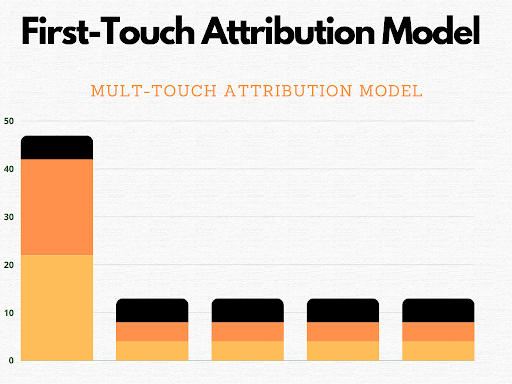
5. 7 Rules-based multi-touch attribution models
1. Equal credit or Linear touch attribution
Linear-touch attribution provides equal credit to every touch point in the consumer’s journey. It is one of the even-weighting models and is considered as standard.
You can divide your credit among all the models easily.
For instance: If a consmer came across an ad from another brand or Casiro.During that phase, credit is divided among both of them as 50%And he then came across different advertisements either through social media posts, Facebook, email newsletters, Twitter, or whatever.in this way, credit is given to all the points with a ratio of 25%.
It is the best way to start with multi-touch attribution. Linear attribution is best when your consumer is in the initial state(consideration phase). It can bring better results than the first-touch and last-touch attribution model.
It provides credit to the first touch point by overlooking the complexity of the entire customer journey.

2. U-shaped model
The U-shaped model provides 40% credit to the first and last touch rather than other touchpoints. U-shaped attribution is optimal when your team aims to prioritise the influence of the first and last touchpoints in your multiple interactions.
For instance: If a consumer comes across a Google ad (related to shopping).
A Facebook ad, a text ad from Google, and an instagram ad.
40% credit will be given to ( first and last touchpoints)Google ad and Instagram ad and the remaining 10% will be given to middle touchpoints
The U-shaped model highlights the importance of both conversion and initial engagement with your brand. It places less emphasis on touchpoints that support the middle stages of the buyer’s journey.

3. W-shaped attribution model
W-shaped attribution is a type of multi-touch attribution. Unlike other models, it allocates percentage credit not only to the first and last touchpoints but also equally distributes credit among the middle touchpoints.
For instance: Let’s consider a scenario where a consumer encounters a Google ad (shopping ad), an article on your website, and then registers for a specific site (webinar). Ultimately, they receive a sales email, and an opportunity coupon leads to conversion. In this case, 30% credit will be attributed to the first touchpoint, the lead that converts, and opportunity creation. The remaining 10% will be allocated to email and conversion.
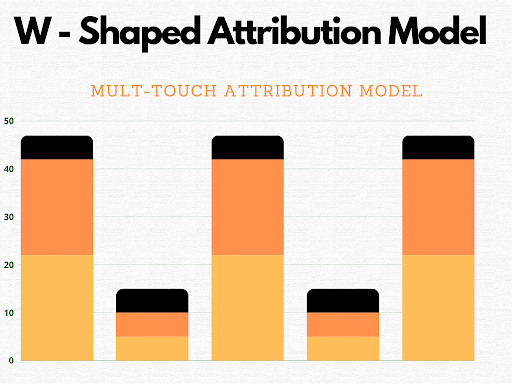
It takes into account both the short-term and long-term impacts of each touchpoint, providing a more comprehensive understanding of your marketing campaign performance.
4. Time Decay attribution model
Time decay is the type of multi-touch attribution in which most of the credit is given to the last touch and less credit is given to the first touch. It helps in building healthy relations.
In time decay attribution, marketing channels that directly play their part in conversion get most of the attention. Using a consistent formula across all your campaigns will help you easily identify changes in the performance of specific channels.
For instance: You are running a campaign. You are using flyers to attract consumers in the beginning which isn’t working the way you think.on the other hand, consumers are more attracted by the call-to-action button on your website. In this way, flyer as a first-touch point gets less percentage credit while call-to-click gets most of it.
The time decay attribution model is best for measuring your short-term goals like a campaign.
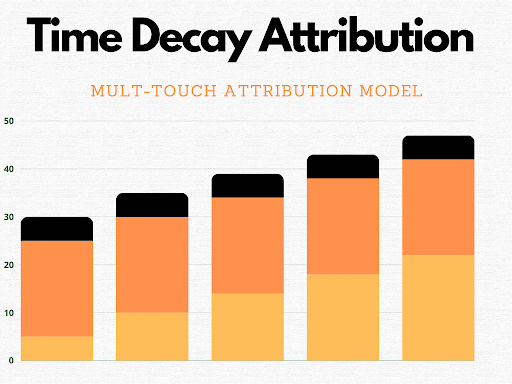
5. Full path multi-touch attribution
The Full Path Attribution Model distributes credit for conversion across key interactions in the customer journey, taking into account the full path to purchase. The full path model represents the most comprehensive and intricate form of multi-touch attribution.
It meticulously tracks every marketing touchpoint a person encounters, from initial exposure to the final conversion stage. This level of detail empowers marketers to gain precise insights into what strategies are effective and what aren’t for individual consumers.
Full path attribution is used to track multiple touchpoints before the first touch and when you are doing account-based marketing.
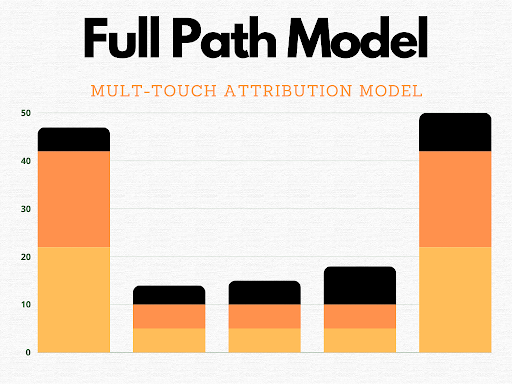
6. Custom Attribution model
The custom attribution model can be formed in three steps. First, you have to collect all the data based on user activity. In the next step, you have to put together all the data. Then you have to decide through the attribution window about giving credit to multiple touch points.
Google Analytics helps you to decide on an attribution window. Google Analytics has a default 30-day or 90-day lookback window. Google Analytics provides a 7 days free trial.
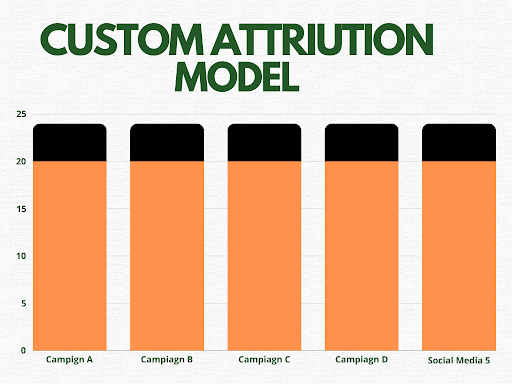
7. Z-shaped attribution model
The z-shaped touch point is the same as the position-based attribution model. Z-shaped attribution gives 22.5 % credit to the touchpoints that play a crucial role in conversion. While the remaining 10% is given to other touchpoints in the marketing funnel.
The Z-shaped model is highly efficient in distributing credit for a sale among different touchpoints. Marketers often struggle to determine which touchpoints have the greatest impact on a customer’s decision, and the Z-shaped model helps address this challenge effectively.
For instance: In a marketing funnel, 22.5% credit is given to the first touch, opportunity creation coupon, and last conversion.
Z-shaped attribution models work best for businesses with lengthy and intricate sales processes. These models are particularly effective when customers need to be nurtured and guided through various stages of the sales funnel.
6. Challenges and Opportunities in Multi-Touch Attribution

Challenges in Multi-Touch Attribution
1. Difficulty in identifying relationship between spending and Conversion
One challenge is identifying the impact attribution, or the correlation between spending and conversion. The greater the correlation between spending and conversion (or revenue), the more significant the impact that channel should be allocated in the attribution model.
2. Less Access to Data
Data refers to unprocessed website visitor information, devoid of any filters, segmentation, or sampling applied. In multi-channel attribution modelling, the use of sampled data introduces additional inconsistencies between the reports and the actual state of affairs.
To obtain an accurate picture, it’s crucial to determine how far into the future you should track conversions.
Opportunities in Multi-touch Attribution
1. Opportunity to learn the consumer journey
Multiple interactions are made before purchase. Interactions are made in total three stages.
Awareness – You have to introduce your company to potential buyers. When introducing your company to potential buyers, you have to captivate their attention right from the start by enticing them about their gain in your solution.
Considerate state enlightens the importance of evaluation of your offer and deep research.
Decision state leads to conversion. You have to put your efforts into your offers which cause purchase.
You have to analyse the marketing funnel at multiple touchpoints. Each model will emphasise different aspects of your sales funnel.
2. Increase Your Marketing ROI
Marketers can pinpoint the most effective channels and campaigns for conversions by assigning value to each touchpoint. You can allocate your efforts and budget to make your strategies successful. The outcome is a more optimised marketing strategy that maximises ROI and reduces wasted resources on less impactful channels.
3. Opportunities for multiple Collaborations and Informed Decision
By comprehending the influence of different touchpoints, businesses can make data-driven decisions that align with customer behavior. Achieving seamless integration of data from various sources can be a significant challenge, as inconsistencies and inaccuracies may emerge, potentially impacting the reliability of attribution models.
Cross-functional teams can collaborate to align strategies, interpret attribution results, and collectively optimise
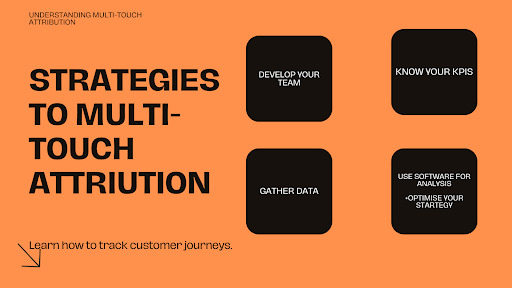
campaigns based on a comprehensive understanding of the customer journey.
7. Strategies of Multi-Touch attribution for data-driven marketing excellence?
Strategy No .1: Figure out which KPIs and Models are best
Multi-touch attribution helps you to figure out which KPIs are best. On which KPIs do we have to work?in multi-touch attribution, various attribution models like first-touch,last-touch, U-shaped full path, W-shaped, Position-based, and custom-based are used. It gives you clear directions about assigning credit to different attribution models.
Strategy No.2: Develop values and objectives within the team
Developing values and objectives in the team is a crucial step in multi-touch attribution. Develop a marketing team for your business. teams must collaborate closely with key team members and stakeholders. Marketing must be talented be skilled enough to fix stuff with stakeholders and to create promotional messages. Set objectives within your skilled team.
Strategy No.3: Gather Data and Analyse it
You should gather data on website visitors, their sources of arrival, and whether they convert. Javascript helps you to collect data based on various interactions at multiple stages.
After collecting next step is to combine it. Webhook was considered a great choice by Nelissen.
You require a method to query and report on all this data, transforming it into graphs and charts for better comprehension. You can use multiple tools for analysing data. One of the tools is the snowflake.
Pricing:
It’s free for the initial stages. However, its team plan begins from $120
Strategy No.4: Implement marketing analysis software and circular strategy
When it comes to marketing attribution, there’s a plethora of software solutions available to kickstart your journey. To select the optimal tool for your specific business needs, identify your marketing attribution goals and pinpoint the types of reports that would provide the most value to your business. We have enlisted few tools here in the blog
Develop the right strategy after fulfilling the above pointers. Multi-touch attribution streamlines your process and cuts down your promotional costs.
8. Multi-Touch Attribution Platform/ tools that will enhance your marketing game
1. HubSpot’s Marketing Analytics
This software tracks and evaluates the effectiveness of your campaigns and marketing endeavors through its integrated analytics, reports, and dashboards.
HubSpot Analytics integrates your CRM and marketing data, enabling you to attribute various touchpoints throughout the customer journey. Hubsopt’s marketing attribution provides you with both contact attribution reporting as well as revenue attribution reporting.

How does Hubspot’s Marketing analytics help you to close high tickets?
- You can create new segments using the data provided by Hubspot’s multi-touch attribution tool.
- You can close high tickets by overcoming the gap between retailing and marketing using Account based marketing (ABM).
Pricing:
Its monthly plan for professionals is starting from 800$
2. Ruler Analytics Multi-touch Attribution
Ruler is a marketing attribution tool that traces the complete customer journey at the individual visitor level, using first-party data. It offers closed-loop marketing attribution, granting you access to all your revenue and conversions in one centralised location.
Ruler correlates user details with their marketing touchpoints and transfers the data to your CRM. Its impression modelling operates independently of cookies, ensuring resilience in the future without relying on third-party cookies.
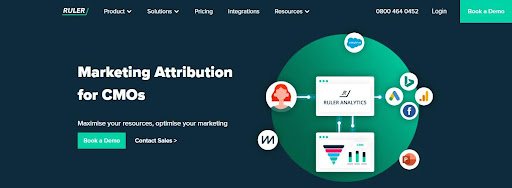
How does Ruler Analytics Multi-touch Attribution help you to increase ROI by enhancing retailing performance?
You can compare various models using ruler analytics. It helps you to allocate budget easily and enhance marketing performance.
It merges dynamic data and mathematical modelling to comprehend how various marketing activities collectively influence conversions and revenue.
Pricing:
Its monthly plan for small businesses starts from £179.
3. Windsor.ai
Windsor.ai is a multi-attribution tool. It integrates data and Data Management Platform (DMP) of it streamlines the process of connecting all your data sources with our Marketing Attribution Software, making it effortless for you. You can concentrate on the insights derived from data integrations and managing your business, rather than investing time in the data integration process.
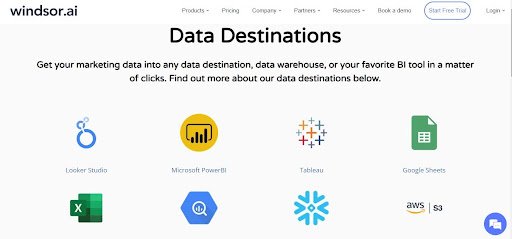
How does Windsor.ai help you to optimise the consumers’ journey?
- You can make decisions by analysing data that will lead to optimising consumers’ journeys.
- Windsor.ai also delivers your Return on Advertising Spend (ROAS) for all touchpoints by merging multi-touch attribution with customer journey data that is matched to cost data.
Pricing:
It provides free trials and its monthly plan begins from $19.
Various other tools can play an integral in multi-touch attribution.
9. Ending Remarks
Giving credit to multi-touch points is necessary. It helps marketers to allocate their budget as well as focus on that particular touchpoint.
The consumer journey is evolving every second and these multi-touch attribution points are necessary. More than 50 interactions are made before a purchase.
You should develop a team that will look into such pointers keenly. Decide your marketing touchpoint and platform as well as your KPIs.Analyse data y using multiple software and tools.
Multi-touch attribution tools give accurate information after analysing data. Are you confused regarding inplemmeting strategies of multi-touch attribution. Our team at Zam Zam World will provide you the best solution.
Which multi-touch attribution tools and strategies you are implementing in your work?